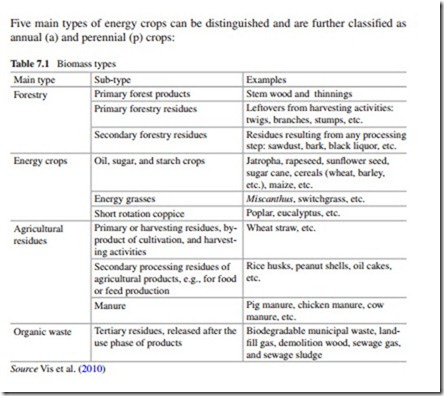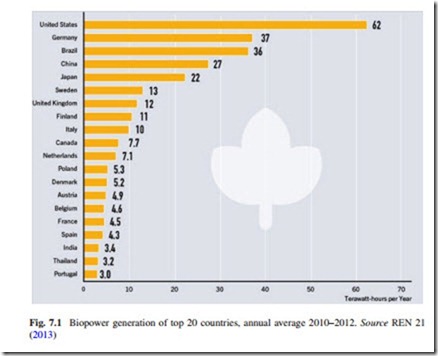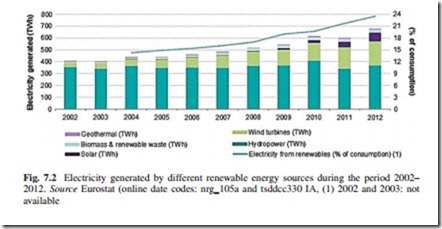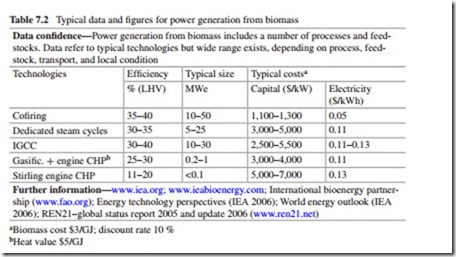Abstract Biomass is a special source of renewable energy in a number of ways. First, it can directly provide all three types of energy carriers: electricity, heat, and fuel (liquids, solids, and gas). Second, it is easily storable and dispatchable, and when there is not enough sun or wind, biomass-fired generators can be ramped up as need be. Third, the major drawback: Biomass requires strict management to be sustainable. No matter how many solar panels we install, we will not use up the sun any faster, nor will we measurably reduce the amount of wind on Earth if we keep installing wind turbines. But with biomass, we have to avoid resource depletion, prevent monocultures from reducing biodiversity, and ensure that the energy needs of rich countries are not met at the expense of food needs in poor countries.
Introduction
According to EC Directive 2001/77 Promotion of electricity produced from renewable energy sources in the internal electricity market, of September 2001, biomass can be defined as “the biodegradable fraction of products, waste, and residues from agriculture (including vegetal and animal substances), forestry, and related industries, as well as the biodegradable fraction of industrial and municipal waste.
According to Vis et al. (2010), the different biomass types can be divided into four categories:
• Forest biomass and forestry residues;
• Energy crops;
• Agricultural residues;
• Organic waste.
In the context of bioenergy, forest biomass includes several types of raw woody materials derived from forests or from the processing of timber that can be used for energy generation (see Table 7.1):
• Stem wood: Biomass from pre-commercial and commercial thinning and final felling, available for energy production, including whole trees and delimbed stem wood from pre-commercial thinning;
• Primary forestry residues: Logging residues and stumps;
• Secondary forestry residues: Wood processing industry by-products and residues, such as sawdust and cutter chips, bark, slabs, lump wood residues, and black liquor;
• Woody biomass: From short rotation plantations on forest lands;
• Trees outside of forests: Such as trees in settlement areas, along roads, and on other infrastructural areas.
Energy Crops
Five main types of energy crops can be distinguished and are further classified as annual (a) and perennial (p) crops:
• Oil containing crops: Like sunflower (a), rape (a), soy (a), oil palm (p), and jatropha (p);
• Sugar crops: Like sugar cane (p), sugar beet (a), and sweet sorghum (a);
• Starch crops: Like corn (a), wheat (a), barley (a), and cassava (a);
• Woody crops: Like poplar (p) and eucalyptus (p);
• Grassy crops: Like miscanthus (p) and switch grass (p);
Agricultural Residues
Agricultural residues are the by-products of agricultural practice. A distinction is made between primary or harvest residues (like straw) that are produced in the fields and secondary residues from the processing of the harvested product (such as bagasse and rice husks) that is produced at a processing facility. Manure is included as a separate category. By-products from further processing of agricultural products, such as molasses and vinasse, are regarded as residues from the food industry and are not included in this group.
Organic Waste
Organic waste includes biodegradable waste from households, industry, and trade activities. Organic waste includes biodegradable municipal waste, construction and demolition wood, and sewage sludge. Biogases from sewage treatment plants as well as landfill gas are also included as energy carriers from organic waste.
Cheap, high-quality biomass (e.g., wood waste) for power generation may become scarce in the future as it is also used for heat production and in the pulp and paper industry. New resources based on energy crops have larger potential, but are more expensive. Technologies and cost of power and heat generation from biomass depend on feedstock quality, availability and transportation cost, power plant size, and conversion into biogas (if any). If sufficient biomass is available, biopower and CHP plants are a clean and reliable power source suitable for base- load service.
Bioenergy can be produced from a variety of biomass feedstock. Through a variety of processes, these feedstocks can be directly used to produce electricity or heat or can be used to create gaseous, liquid, or solid fuels.
The range of bioenergy technologies is broad and the technical maturity varies substantially. Some examples of commercially available technologies include small- and large-scale boilers, domestic pellet-based heating systems, and ethanol production from sugar and starch. Advanced biomass-integrated gasification combined-cycle power plants and lignocellulose-based transport fuels are examples of technologies that are at a pre-commercial stage, while liquid biofuel production from algae and some other biological conversion approaches are in the research
and development phase. Bioenergy technologies have applications in centralized and decentralized settings, with the traditional use of biomass in developing countries being the most widespread current application. Bioenergy typically offers constant or controllable output. Bioenergy projects usually depend on local and regional fuel supply availability, but recent developments show that solid biomass and liquid biofuels are increasingly traded internationally (Special Report of the Intergovernmental Panel on Climate Change 2012).
Biomass is a special source of renewable energy in a number of ways. First, it can directly provide all three types of energy carriers: electricity, heat, and fuel (liquids, solids, and gas). Second, it is easily storable and dispatchable, and when there is not enough sun or wind, biomass-fired generators can be ramped up as need be. Third, the major drawback: biomass requires strict management to be sustainable. No matter how many solar panels we install, we will not use up the sun any faster, nor will we measurably reduce the amount of wind on Earth if we keep installing wind turbines. But with biomass, we have to avoid resource deple- tion, prevent monocultures from reducing biodiversity, and ensure that the energy needs of rich countries are not met at the expense of food needs in poor countries.
In 2005, EU-27 electricity production from biomass was 102 TWh. According to the NREAPs approved, biomass-sourced electricity production is forecasted to increase to 232 TWh in 2020; this represents an increase of more than double of the level reached in 2005. Electricity production from solid biomass is pro- jected to increase by 78 TWh. The largest additions in biomass-sourced electricity are expected in Germany, UK, France, the Netherlands, and Italy. In Europe, bio- power capacity increased by almost 2 % in 2012 to 31.4 GW and generated around 136 TWh. Of this total, 35.9 TWh was produced by biogas in CHP plants, and 18.2 TWh was generated by the renewable municipal solid waste. Germany, Europe’s leading biopower producer, increased its generation by 11 % to 41 TWh, with half of this coming from biogas power plants. Total biopower capacity rose 0.3 GW (mostly biogas CHP plants) to more than 7.6 GW, although new construction slowed in 2012 relative to previous years. Germany’s CHP plants generated 20.5 TWh of electricity in 2012 (up from 17.5 TWh in 2011, an increase of 17.1 %), amounting to around half of Europe’s electricity generated with biogas (REN 21, 2013).
According to Fig. 7.1, out of the 20 top countries in the use of biomass, included in that figure, 13 are located in the European region (65 %).
Biomass is a renewable energy source that in 2012 contributes to 4.3 % of EU energy supply, predominately in combined heat and power (CHP) applications in unit sizes of 10–30 MW. It is estimated that market potential in the EU could rise from 3,862 MW in 1995 to 8,766 MW in 2010, especially for biomass applications in decentralized plants and for substituting fossil fuel in electricity generation. Future trends are likely to be toward larger unit sizes of 50–100 MW and increase in efficiency of up to 50 %. New technologies, including biomass-integrated gasification combined cycle, are increasing the efficiency of biomass generation of electricity. Efficiencies of up to 80 % are possible in CHP operations. Multi-fuel operations are likely to be enhanced, in particular, as the results of incorporating biomass use into CHP installations.
The EC policy aims for a strong increase of renewable energy in the EU’s over- all energy mix (from a little over 10 % today to 20 % by 2020) and a consider- able increase of the share of biofuels in the transport sector, with a target of 10 % of vehicle fuel by 2020. To achieve this increase, it is envisaged in the NREAPs, which has been compiled by the EU-27 countries that the energy generated from biomass will nearly double by 2020. Although the relative importance of biomass in the renewable sector is expected to decrease slightly from about two-thirds, it will nevertheless continue to play a very important role within the renewable sector.
In every EU member state, there are already some stated targets for increased production of renewable energies. After the transition period of the Directive 2009/28/EC (i.e., by December 5, 2010), each member state will have imple- mented the mandatory targets in their national legislation. However, the political framework to support the targets differs from country to country, ranging from strong financial incentives to no measures at all—or even political barriers. Policy measures, targets, and choices have proven to be of vital importance for the success of bioenergy sector development. It should be ensured that bioenergy is con- sidered an integral part of energy, agriculture, forestry, waste, and industrial policies. Such a holistic approach to biomass is much needed in order to avoid
future conflicting developments and to maximize the benefits of bioenergy deploy- ment2 (Koch 2011).
Biomass-fired power plant’s output has increased from 38.7 TWh in 2000 to
102.1 TWh in 2008, which makes biomass the second largest renewable electricity source in the EU. Germany has more than quadrupled its biomass electricity generation from 2000 to 2008. Second largest bioelectricity producer, Sweden, has also almost tripled its bioelectricity production, while in Finland growth has been slower (Ruska and Kiviluoma 2011). According to the document entitled “The Market for Biomass Power Plants in Europe” shows that electricity generation from biomass in the European region is expected to increase by 2,900 MW by 2013, especially in the UK and France. Currently, about 800 biomass power plants are operational in the European Economic Area. The paper stresses that over the past five years, the number of biomass power plants in the European region almost doubled. These 800 biomass power plants that are operating in 23 countries convert thermal energy from the incineration of wood, black liquor, or other biomass into electrical energy. The electrical power of these plants increased from 5,300 MW in 2003 to more than 10,000 MW by the end of 2013; this repre- sents an increase of 88.7 % for the whole period. The growth in electricity generated from renewable energy sources during the period 2002–2012 (see Fig. 7.2) largely reflects an expansion in three renewable energy sources, namely wind turbines, solar power, and biomass. In the particular case of biomass, the quantity of electricity generated from this type of energy source (including renewable waste) more than doubled in the same period. The relative shares of wind turbines and biomass in the total quantity of electricity generated from renewable energy sources rose to 30.4 and 4.1 %, respectively in 2012.
The main reason for the strong market growth is the intensified promotion of the electricity generation from biomass within several European countries. By now, almost all of the European countries have introduced FiTs for electricity from biomass. Additionally, several states raised the subsidy rates significantly in the last years. The densely wooded Scandinavian states continue to boost the most and the largest biomass power plants, although there are also a lot of facilities in Germany and Austria—first and foremost because both states subsidize the elec- tricity generation from biomass comparatively intensely and for a long time.
However, countries such as France, the UK and the Baltic states will intensify the use of biomass for generating electricity during the coming years. There will also be further extensions of existing capacities in the well-established markets like those in Sweden, Finland, Denmark, and Germany. The pace of this construction, however, will remain constant or even decelerate slightly. Already today, a lot of operators in Germany feared surplus capacities—and, as a result, increasing fuel prices. The incinerators of scrap wood face a very distinct situa- tion. Due to the economic crisis, this mass flow decreased sharply at last, which caused a dramatic rise in prices. A large number of companies were actively engaged during 2012 in supplying bioenergy plants that convert biomass to heat and electricity. In Europe, for example, the Finnish company METSO installed several 8 MWth bioheat plants to replace oil in district heating schemes and developed a 13.4 MWth heat plant in Värnamo, Sweden. In the UK, as of early 2013, ETSOVER ENERGY was developing three biomass CHP plants totaling 52 MW, and Sweden completed its Pyrogrot demonstration project, which will use 270,000 tons of dry forest residues to produce around 160,000 tons per year of pyrolysis oil with a total energy content estimated at about 2.59 PJ (REN 21 2013). The biomass potential in Europe can reach up to more than 4,300 PJ in 2020 and would increase to about 5,000 PJ in 2030 under the free trade setting. And so, if for example, there is a €35 per ton incentive for biomass plantations, the total biomass subsidy needed to achieve the total potential of 4,300 PJ would amount to about €7,200 million in 2020.
It is important to know that according to IEA sources, biomass cofiring in modern coal power plants with efficiencies up to 45 % is the most cost-effective biomass use for power generation. Due to feedstock availability issues, dedicated biomass plants for CHP are typically of smaller size and lower electrical efficiency compared to coal power plants (30–34 % using dry biomass and around 22 % for municipal solid waste). In cogeneration mode, the total efficiency may reach 85–90 %. Biomass-integrated gasification in gas turbine plants is not yet commercial, but integrated gasification combined cycles using black liquor (a by-product from the pulp and paper industry) are already in use. Anaerobic digestion to pro- duce biogas is expanding in small, off-grid applications. Biorefineries may open the door to combine cost-effective production of biochemicals, electricity, and biofuels.
Generally, results suggest that in the presence of economic incentives such as subsidies, the competitive potentials of different bioenergy markets will increase despite constraint on the conversion of land for biomass plantations. Gradual improvements in biomass subsidies correspond to higher biomass production potential, but may significantly affect the potentials of other land-use categories due to the substantial pressure on land brought about by the amplified biomass activities.
Because of the variety of feedstock and processes, costs of biopower vary widely. Cofiring in coal power plants requires limited incremental investment (US$ 50–US$ 250 per kW) and the electricity cost may be competitive (US$ 20 per MWh), if the local feedstock is available at low cost (no transportation). For biomass typical cost of US$ 3–US$ 3.5 per GJ, the electricity cost may exceed US$ 30–US$ 50 per MWh. Due to their small size, dedicated bio- mass power plants are more expensive (US$ 1,500–US$ 3,000 per kW) than coal power plants. Electricity costs in cogeneration mode range from US$ 40 to US$ 90 per MWh. The electricity cost of new gasification plants is around US$ 100– US$ 130 per MWh, but with significant reduction potential in the future.
The inclusion of sustainability parameters in the assessment, which aimed to avoid negative environmental impacts of indirect land-use change, therefore, restrict the resulting potential through limiting the area of land available for bioenergy use.
Table 7.2 includes typical data and figures associated to the power generation from biomass.



